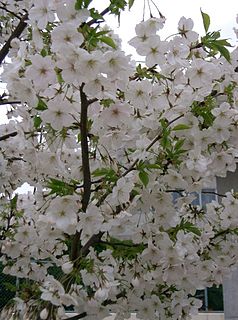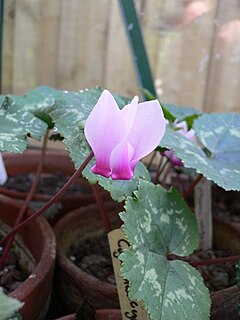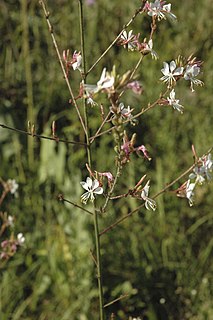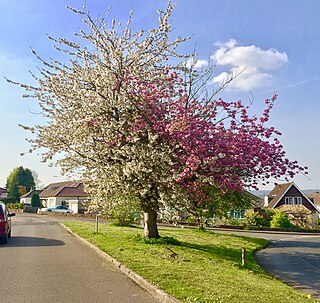
In botany, blossoms are the flowers of stone fruit trees and of some other plants with a similar appearance that flower profusely for a period of time in spring.

Cornus florida, the flowering dogwood, is a species of flowering tree in the family Cornaceae native to eastern North America and northern Mexico. An endemic population once spanned from southernmost coastal Maine south to northern Florida and west to the Mississippi River. The tree is commonly planted as an ornamental in residential and public areas because of its showy bracts and interesting bark structure.

Caryophyllaceae, commonly called the pink family or carnation family, is a family of flowering plants. It is included in the dicotyledon order Caryophyllales in the APG III system, alongside 33 other families, including Amaranthaceae, Cactaceae, and Polygonaceae. It is a large family, with 81 genera and about 2,625 known species.

A cherry blossom is a flower of many trees of genus Prunus or Prunus subg. Cerasus. They are also known as Japanese cherry and sakura. They generally refer to ornamental cherry trees, not to edible cherry trees. It is considered the national flower of Japan.

Hanami is the Japanese traditional custom of enjoying the transient beauty of flowers; flowers ("hana") are in this case almost always referring to those of the cherry ("sakura") or, less frequently, plum ("ume") trees. From the end of March to early May, cherry trees bloom all over Japan, and around the first of February on the island of Okinawa. The blossom forecast "cherry blossom front" is announced each year by the weather bureau, and is watched carefully by those planning hanami as the blossoms only last a week or two.

Hibiscus rosa-sinensis, known colloquially as Chinese hibiscus, China rose, Hawaiian hibiscus, rose mallow and shoeblackplant, is a species of tropical hibiscus, a flowering plant in the Hibisceae tribe of the family Malvaceae. It is widely cultivated in tropical and subtropical regions, but is not known in the wild, so that its native distribution is uncertain. An origin in some part of tropical Asia is likely. It is widely grown as an ornamental plant in the tropics and subtropics.

Prunus serrulata is a species of cherry trees which was born from complicated interspecific hybrids such as Oshima cherry, Prunus jamasakura, Prunus sargentii, Prunus pendula, Prunus leveilleana, Prunus apetala, Prunus incisa, Prunus campanulata, whose mother line is Oshima cherry, which is an endemic species in Japan. Japanese have produced many cultivars from this species, also known as the Cerasus Sato-zakura Group.

A flower, sometimes known as a bloom or blossom, is the reproductive structure found in flowering plants. The biological function of a flower is to facilitate reproduction, usually by providing a mechanism for the union of sperm with eggs. Flowers may facilitate outcrossing resulting from cross pollination or allow selfing when self pollination occurs.

Dicentra cucullaria, or Dutchman's breeches, is a perennial herbaceous plant, native to rich woods of eastern North America, with a disjunct population in the Columbia Basin.

Magnolia kobus, known as mokryeon, kobus magnolia, or kobushi magnolia, is a species of Magnolia native to Japan and Korea and occasionally cultivated in temperate areas. It is a deciduous, small to tall tree which has a slow rate of growth but can reach 8–15 m (25–50 ft) in height and up to 10 m (35 ft) in spread.

Prunus speciosa, the Oshima cherry, Japanese オオシマザクラ, is native to Izu Ōshima island and the Izu Peninsula on Honshū near Tokyo, Japan.

Dicentra eximia is a flowering plant with fernlike leaves and oddly shaped flowers native to the Appalachian Mountains. It is similar to the Pacific bleeding-heart, which grows on the Pacific Coast.

Cyclamen coum, the eastern sowbread, is a species of flowering plant in the family Primulaceae. It is a tuberous herbaceous perennial, growing to 5–8 cm (2–3 in), with rounded heart-shaped leaves and pink shell-shaped flowers with darker coloration at the base. It is valued in horticulture as groundcover, and for the flowers which bloom in winter and early spring.

Cyclamen rohlfsianum is a species of perennial plant in the family Primulaceae. It is endemic to Libya. It grows from a tuber in shrubland, especially in limestone cracks, up to 450 m (1,500 ft) above sea level. It is one of the tenderest cyclamen species. The plant was discovered by Friedrich Gerhard Rohlfs in 1879, and was named after him in 1897 by Paul Friedrich August Ascherson.

Cassia javanica, also known as Java cassia, pink shower, apple blossom tree and rainbow shower tree, is a species of tree in the family Fabaceae. Its origin is in Southeast Asia, but it has been extensively grown in tropical areas worldwide as a garden tree owing to its beautiful crimson and pink flower bunches.

Prunus nipponica, also called Japanese alpine cherry, is a shrub which originates from the islands of Hokkaido and Honshu, Japan. It grows to a height of about 5 meters (16 ft) and can grow in sandy, loamy, and clay soils.

Prunus 'Kanzan' is a flowering cherry cultivar. It was developed in the Edo period in Japan as a result of multiple interspecific hybrids based on the Oshima cherry.

Oenothera guara, formerly known as Gaura biennis, the biennial gaura or biennial beeblossom, is a North American flowering plant that can reach 6 ft (1.8 m) in height at maturity. Its upper half is made up of flowering stems, which are covered with soft, white hairs. It has light pink colored flowers, which turn a vibrant red/pink color in the late summer to early fall seasons. These colors make this plant attractive to butterflies and bees, and are in full bloom just before many fall plant species begin to bloom.

North American azaleas are flowering shrubs in the genus Rhododendron, section Pentanthera, subsection Pentanthera, so named because they all have five stamens. Most are in the United States, with one species found in Canada and one being found in Mexico. North American azaleas are commonly confused with azaleas of Asian origin, the evergreen azaleas. North American azaleas are deciduous and produce two types of buds. One is a larger and produces about 20 flowers while the other bud produces a leafy shoot. The flower color, fragrance, and number of stamens vary among species.

The Strawberries and Cream Tree is a graft hybrid cherry tree in Backwell, North Somerset, England. Planted on council land in the 1950s, it is noted for producing two distinct colours of blossom: pink blossom on one side of the tree and white on the other, when it blooms every spring. This gave rise to the name 'Strawberries and Cream Tree', which was coined by children of the village.


















